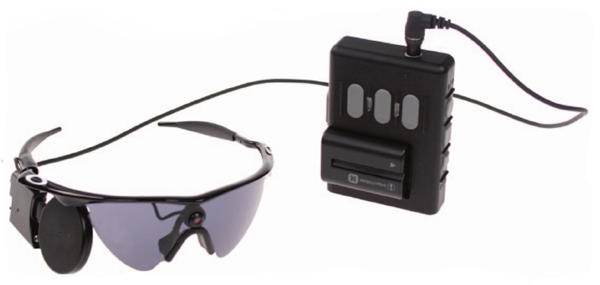
Sight Restoration Comes into Focus
Sight Restoration Comes into Focus
By Leslie Mertz
NOTE: This is an overview of the entire article, which appeared in the September/October 2012 issue of the IEEE Pulse magazine.
Click here to read the entire article.
By late 2012, the Argus II visual prosthesis may be approved for sale in the United States. Already available in Europe, the first commercially available device of its kind has caused excitement.
As the author points out, the Argus II, produced by Second Sight Medical Products Inc. of Sylmar, California, utilizes one of two major approaches to restoring sight. It employs a retinal implant, in this case one having a 60 electrode array positioned in front of the retina.

The external components of the Argus II include a pair of glasses with a very small video camera embedded in the bridge of the nose piece. The camera’s video signal is processed by a rectangular, hip-worn computer (shown) called a VPU. The patient can control the signal for varying levels of contrast, brightness, and other parameters. (Photo courtesy of Second Sight Medical Products Inc.)
A small video camera, mounted on eyeglasses, generates a video signal. This signal is processed in a device worn on the hip, and is wirelessly transmitted to a receiver and stimulator which are implanted under the conjunctiva of the eye. The stimulator drives the electrode array, which activate neurons in the retina.
Another company, Bionic Eye Technologies, created by the Retinal Implant Research Group at MIT and the Massachusetts Eye and Ear Infirmary, is one of a number of other firms hoping to break into the retinal implant market. Their approach is to place an array of over 256 electrodes on the rear of the retina They consider the electrode placement to be an advantage in the ease of implantation and longevity of the array. The article describes several other retinal implant devices that are in the works.
The major alternative to a retinal implant is a corticial implant, which applies the visual information to the visual cortex of the brain. Corticial implants offer restoration of sight to patients whose optic neural pathway to the brain is not functioning. In addition, the surface area on the cortex is much larger than on the retina, which may offer advantages over retinal implantation. However, the method of communicating with the cortex is still far from solved.
The Intracorticial Visual Prosthesis team at the Illinois Institute of Technology (IIT) has been developing an implantable 16 element electrode array, and have received funding to further develop the technology, with the aim of performing a human clinical trial. The team believes that they can place a 600 to 1000 electrode array within the human visual cortex.
At the University of Utah, a group is doing animal tests of the Utah Electrode Array. They have implanted their array in the visual cortex of monkeys over a two year period, verifying the viability of the array over that length of time.
This and other studies are underway at a rapid pace, seeking to best design visual prostheses to help people with visual impairments.






